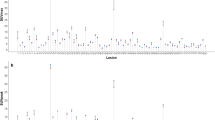Abstract
Although PET/CT scanners have the potential for precise fused registration of structures visualized on both PET and CT, physiological motion during the acquisition of both studies may alter the appearance of organ shape, size or location. The degree of possible mismatch in abdominal organ size and position between PET and CT has not been evaluated. The aim of this study was to assess the consistency in location and measured size of upper abdominal organs with PET and CT using a combined PET/CT system. Forty-six consecutive inpatients who underwent clinical PET/CT scans for suspected cancer were evaluated. CT and PET images attenuation corrected by both CT and germanium-68 transmission scans were obtained, and we separately determined the location of the top and bottom (height), anterior and posterior margins (thickness), and right and left margins (width) for each organ, including liver, spleen, and bilateral kidneys, using CT and both sets of PET images. Differences between the two modalities in terms of location and measured organ size were investigated. In the upper margin of the liver and lower margin of the spleen, more than 10% of the cases showed a larger discrepancy (>20 mm) between CT-based and Ge-corrected PET-based measurements, although the differences in the positions of the edges were less than 10 mm in most cases. The center of the liver tended to be located cephalad and to the right of the body, and that of the spleen tended to be cephalad and posterior on PET, as compared with CT. Moreover, the center of both kidneys tended to be seen cephalad, posterior, and to the right on PET. The liver appeared slightly larger on PET than CT in thickness (CT vs CT-corrected PET vs Ge-corrected PET = 156 mm vs 162 mm vs 162 mm) and width (186 mm vs 189 mm vs 188 mm). By contrast, the spleen appeared slightly smaller on PET than CT in height (84 mm vs 77 mm vs 80 mm) and width (85 mm vs 81 mm vs 80 mm). A similar tendency was observed in the left kidney (105 mm vs 100 mm vs 99 mm in height, and 64 mm vs 59 mm vs 58 mm in width) and the right kidney (99 mm vs 93 mm vs 93 mm in height, and 64 mm vs 59 mm vs 60 mm in width). These differences between the two modalities were statistically significant (P<0.05). In conclusion, minor mismatches in location and organ size were found to exist between CT and PET images, in part due to physiological motion. Although these differences could potentially affect the quality of the image registrations, they were generally of a modest nature.




Similar content being viewed by others
References
Bar-Shalom R, Valdivia AY, Blaufox MD. PET imaging in oncology. Semin Nucl Med 2000; 30:150–185.
Delbeke D, Martin WH. Positron emission tomography imaging in oncology. Radiol Clin North Am 2001; 39:883–917.
Korin HW, Ehman RL, Riederer SJ, Felmlee JP, Grimm RC. Respiratory kinematics of the upper abdominal organs: a quantitative study. Magn Reson Med 1992; 23:172–178.
Schwarz AJ, Leach MO. Implications of respiratory motion for the quantification of 2D MR spectroscopic imaging data in the abdomen. Phys Med Biol 2000; 45:2105–2116.
Weiss PH, Baker JM, Potchen EJ. Assessment of hepatic respiratory excursion. J Nucl Med 1972; 13:758–759.
Harauz G, Bronskill MJ. Comparison of the liver's respiratory motion in the supine and upright positions: concise communication. J Nucl Med 1979; 20:733–735.
Beyer T, Townsend DW, Brun T, Kinahan PE, Charron M, Roddy R, Jerin J, Young J, Byars L, Nutt R. A combined PET/CT scanner for clinical oncology. J Nucl Med. 2000; 41:1369–1379.
Kluetz PG, Meltzer CC, Villemagne VL, Kinahan PE, Chander S, Martinelli MA, Townsend DW. Combined PET/CT imaging in oncology. Impact on patient management. Clin Positron Imaging 2000; 3:223–230.
Kaim AH, Burger C, Ganter CC, Goerres GW, Kamel E, Weishaupt D, Dizendorf E, Schaffner A, von Schulthess GK. PET-CT-guided percutaneous puncture of an infected cyst in autosomal dominant polycystic kidney disease: case report. Radiology 2001; 221:818–821.
Zasadny KR, Kison PV, Francis IR, Wahl RL. FDG-PET determination of metabolically active tumor volume and comparison with CT. Clin Positron Imaging 1998; 123–129.
Goerres GW, Kamel E, Heidelberg TH, Schwitter MR, Burger C, von Schulthess GK. PET-CT image co-registration in the thorax: influence of respiration. Eur J Nucl Med 2002; 29:351–360.
Hamacher K, Coenen HH, Stocklin G. Efficient stereospecific synthesis of no-carrier-added 2-[18F]-fluoro-2-deoxy-d-glucose using aminopolyether supported nucleophilic substitution. J Nucl Med 1986; 27:235–238.
Davies SC, Hill AL, Holmes RB, Halliwell M, Jackson PC. Ultrasound quantitation of respiratory organ motion in the upper abdomen. Br J Radiol 1994; 67:1096–1102.
Suramo I, Paivansalo M, Myllyla V. Cranio-caudal movements of the liver, pancreas and kidneys in respiration. Acta Radiol Diagn (Stockh) 1984; 25:129–131.
Townsend DW. A combined PET/CT scanner: the choices. J Nucl Med 2001; 42:533–534.
Acknowledgement
The authors gratefully acknowledge the editorial assistance of Julia Buchanan.
Author information
Authors and Affiliations
Corresponding author
Rights and permissions
About this article
Cite this article
Nakamoto, Y., Tatsumi, M., Cohade, C. et al. Accuracy of image fusion of normal upper abdominal organs visualized with PET/CT. Eur J Nucl Med Mol Imaging 30, 597–602 (2003). https://doi.org/10.1007/s00259-002-1080-2
Received:
Accepted:
Published:
Issue Date:
DOI: https://doi.org/10.1007/s00259-002-1080-2




